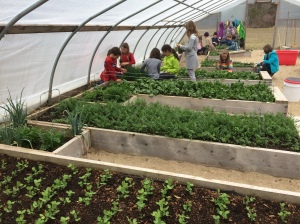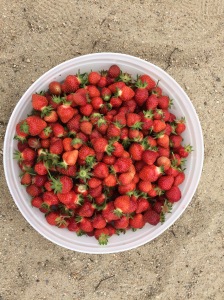
A few years ago the children at our school grew, harvested and ultimately ate a giant, two-pound carrot.
Our organic gardening program at the Waldorf School of Cape Cod has come a long way since then. We now have a unheated Sunhouse and a program where middle school gardeners lead first through fifth graders as they learn to build soil, plant, transplant, tend, water and harvest food year round. Our harvests are transformed by our school chef into amazing meals served at lunch.
The summer tending of the garden is a community responsibility. We have weekly Family Gardening sessions organized by grade level where families share a pot luck meal and then work together in the garden in the cool of the evening.
The 24 by 48 feet Sunhouse is the heart of our gardening program. It is an indoor gardening classroom that aligns the school year with garden life by spreading the harvest over four seasons. Since it is unheated, we choose winter crops such as carrots, spinach and kale that grow when the nights are very cold and the days are slightly warm. A sunny day in February can bring temperatures in the 20s outside and in the sixties in the Sunhouse. The night lows in the hoop house can go into the teens or 20s, Yet, since the soil is warmed by the sun during the day, the soil in the beds never freezes. Our inspiration for the growing methods we use comes from Eliot Coleman who has written books about growing in four seasons in Maine. http://www.fourseasonfarm.com
Our spring Sunhouse harvests are substantial. We have early strawberries, bushels of spinach and baby kale, lots of chives and parsley and snow peas. The plastic roof is removed for the summer months to avoid overheating.
Most greenhouse farmers cover most of their indoor space with plants. We are growing kids as well as plants, so only half the space in the greenhouse is covered with growing beds. We have a space to congregate at one end. The children had the idea to use sand rather than gravel between the beds and this has made the hoop house serve double duty as a protected winter sandbox. The used structure was bought through Craigslist and dedicated parents rebuilt the structure at school and built garden beds.
While every student in the school devotes some time each year to growing lunch, each year the third graders are our weekly farmers. They are in charge of turning lunch scraps into compost in our tumbling composter. And, a worm bed in the hoop house creates vermicompost http://en.wikipedia.org/wiki/Vermicompost with the help of thousands of red worms.
I am continually awed by the energy and engagment children pour into all aspects of gardening. Our local newspaper made a video about the giant carrot that shows their tremendous enthusiasm.
This week my class is studying botany and specifically the growth of seeds by tucking seeds between the wall of a clear plastic tub and a few layers of wet paper towels. I gave the class permanent markers so they could write their own names on the tubs. Soon I realized that the quart containers were covered with more than their own names. They had given each seed a name: Poseidon, Zeus, Heidi! Now, each morning, I hear delighted exclamations, “One of our beans has sprouted! Heidi has a root!” “We have a sprouted leek seed. You have to look quite carefully to see it.” This is a hands-on exploration of monocotyledons (the leek is an example) and dicotyledons (the bean is an example). The children are learning those terms and what they mean. But, in my mind, even more vital is that they are given the opportunity to celebrate life. This part of the lesson does not need to be taught. It just rises up from within them, as naturally as the rising of the sun, as irrepressibly as the sprouting of the bean seed.
We seem to be a culture that is anxious about whether our children are learning enough, learning soon enough, learning exactly the right information. But, in the end, it is enthusiasm and care for life and learning that will carry them. Who can list with any certainly all of the facts, understandings and skills our children will need to possess twenty, thirty and forty years from now? Certainly, they will need to assimilate much that we cannot even imagine. (If you are my age you know that forty years ago you could never have imagined taking pictures with your phone, nor could anyone have pictured then the tech jobs of this decade.)
Why teach gardening? To help children make good food choices? Yes. To learn about botany? Yes. To bring healthy exercise into the school day? Yes. To give children an understanding of the work behind their food? To teach them how to grow their own food ? Yes. But, most of all, let’s grow with children in order to fuel their natural enthusiasm for life.
For more about Family Gardening read https://childrengrowing.com/2015/09/08/do-you-think-this-could-become-as-big-as-baseball/
The giant carrot video:


This is so awesome and inspiring! Another amazing year-round growing system is the Tower Garden: a vertical, aeroponic growing system that uses up to 90% less water than traditional gardening and uses NO SOIL! There are classrooms around the country that have implemented Tower Gardens for hands-on education. Check it out: http://www.andreadill.towergarden.com
LikeLike
This program teaches so much to our kids. The Farm to Table concept is a great way to teach our children where their food comes from. I
LikeLike
That’s a perfect size greenhouse to incorporate the Learning Green program for schools which utilizes Tower Gardens. http://www.learninggreen.info 🙂
LikeLike
Are city council members and elected officials living in a different world than the rest of us? Do they not have their own FB accounts and have home in our neighborhoods? You make it sound as if these people live on a different planet. These people are our neighbors, their kids go to our neighborhood schools (I know, I taught some of them and met their parents who are elected officials at back to school nights, etc. when checking on their kids’ progress). Before they are elected they work in jobs we work in, go to the same stores, etc. we go to. Yes, they see what’s on FB just like we do. I guarantee you that elected officials read the their FB walls from time to time and they can see this too! It can be one more influential step along the way to building and growing these programs. Surely FB isn’t the only avenue that this program is marketing itself on, but FB is an influential outlet.
LikeLike
Tower garden would work in our unheated greenhouse in our climate for about 8 months of the year. My guess is that their tall shape would make it more likely for the soil in them to freeze in winter than the soil in our garden beds which have more thermal mass. We would be happily to experiment with one and tell you how it goes!
LikeLike
Thank you so much for sharing your ideas and all you’re doing to grow our next generation. I agree with your approach to preparing kids for our future.
If you don’t know about it already, you may be interested in Hood River Middle School in Oregon that bases its entire curriculum around permaculture principles. The kids do some gardening, but the gardening is more a vehicle for teaching academics and STEM fields, critical thinking, teamwork, problem solving and social skills, etc. It seems to me that this integrated approach addresses the issues of differing learning styles, “connects the dots” between concepts and application and can encourage creative/divergent thinking. Also, the direct cause and effect of their actions is a valuable lesson for kids.
It’s all good! Thank you for helping to make Cape Cod a great place to grow and live!
LikeLike
hello Kim this is beautiful. Are you aware of any moments in Toronto Canada I am looking to get involved in something like this over here
LikeLike
Sorry I’m not aware of something similar in Toronto. It’s the perfect climate for an unheated hoop house. The program I write about is at a Waldorf school. Looks like the Toronto Waldorf school has an agriculture program with a greenhouse. But I don’t know how they use the greenhouse or whether they welcome volunteers
LikeLike